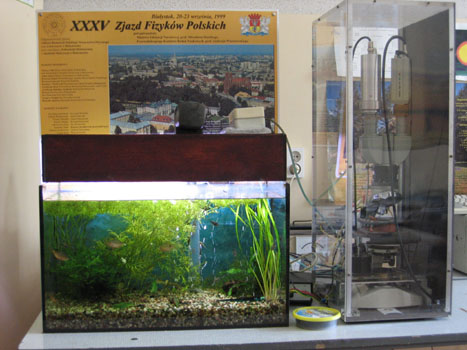General scheme of remote type of experimental set-up is shown in Fig. 4.1. Fig. 4.2 illustrates technical solution for our remote experiment “Magnetism by Internet”. In a remote experiment Internaut could : (i) change experimental conditions (in our case: amplitude of external magnetic field H; a angle between polaryzer and analyzer); (ii) choose parameters for measurements (in our case number of measurements used for signal averaging); (iii) receive measured data (in our case: voltage-signal V(H,a) from the light detector in the microscope; magnetic domain images I(H,a) from the microscope; live-image of experimental set-up – an example is shown in Fig.4.3. CGI ( Common Geteway Interface ) enables communication between www server and the computer driving the experiment. Experimental data are available for Internaut by dynamically generated www pages.
 |
| Fig 4.1 Scheme of remote experiment |
Our experimental set-up is based on polarizing optical microscope with: (i) computer driven step motor changing polaryzer position; (ii) the sample – garnet film is placed in air coil producing magnetic field H perpendicular to the film plane, the computer driven power supply allows H amplitude changes; (iii) two light detectors – CCD camera and light diode.
Four types of experiment are available :
- Study of Malus law and Faraday effect
- Registration of magnetic hysteresis loop
- Observation of magnetic domains
- Observation of experimental setup on-line
The proposed experiments give opportunities to reach different levels of understanding (qualitative and quantitative) of basic magnetism. The experiments are supported by different levels of theoretical descriptions presented in chapters 1-3. Using the description an Internaut could determine different material parameters such as : Faraday rotation angle, domain wall energy, magnetization saturation,…
The goals of the following experiments are:
- to study physics of magnetization processes;
- to measure domain sizes and register the magnetic hysteresis loop of a thin garnet film;
- to understand the physics of simplest domain structure – stripe domain structure, and determination of the material parameters of a given film;
- to learn the magnetooptical domain imaging technique.
 |
| Fig. 4.1 Scheme of our remote experiment Magnetizm by Internet. |
  |
| Fig 4.3 Image of experimenta set-up optical microscope with living object working aquarium with fishes. |